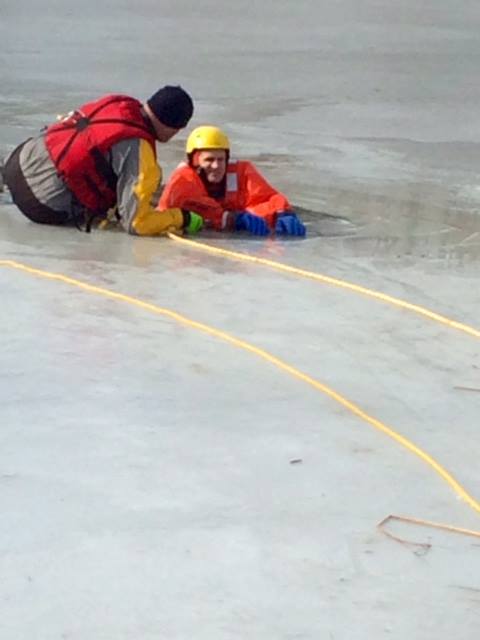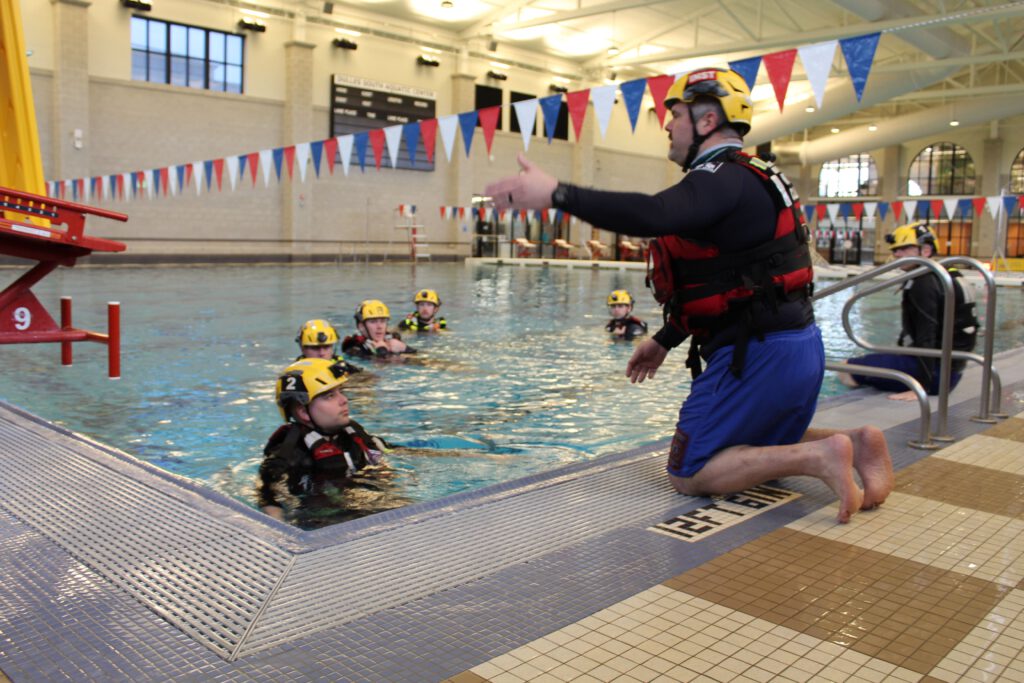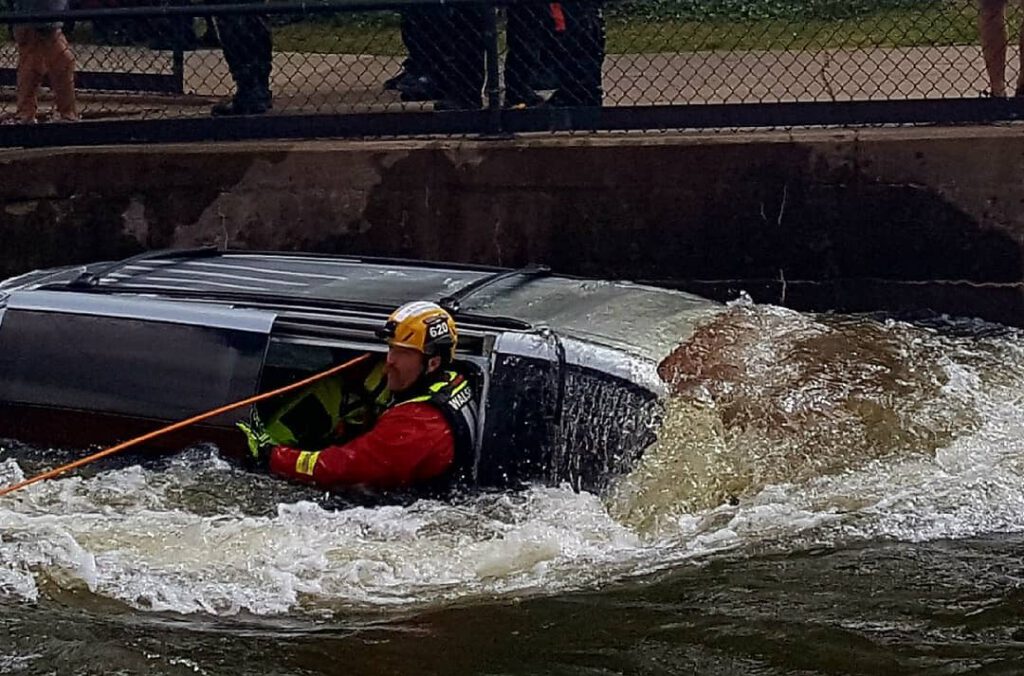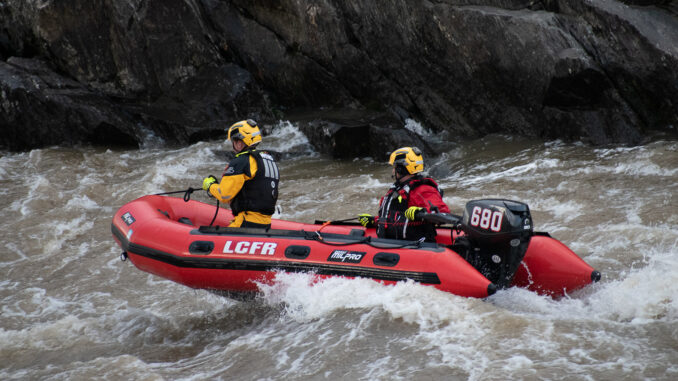
TO THE RESCUE
By Chris Wadsworth
It was April 2017. Late afternoon. A family of five – two adults and three children – was boating on the Goose Creek just off Belmont Ridge Road in Ashburn.
Suddenly, their motor failed. The tiny boat started to drift toward the dam, where water flowed down 20 feet into the adjacent reservoir. The family scrambled into the front of the backwards-angled boat just in time, weighing it down enough to keep them from tumbling over the lip of the dam.
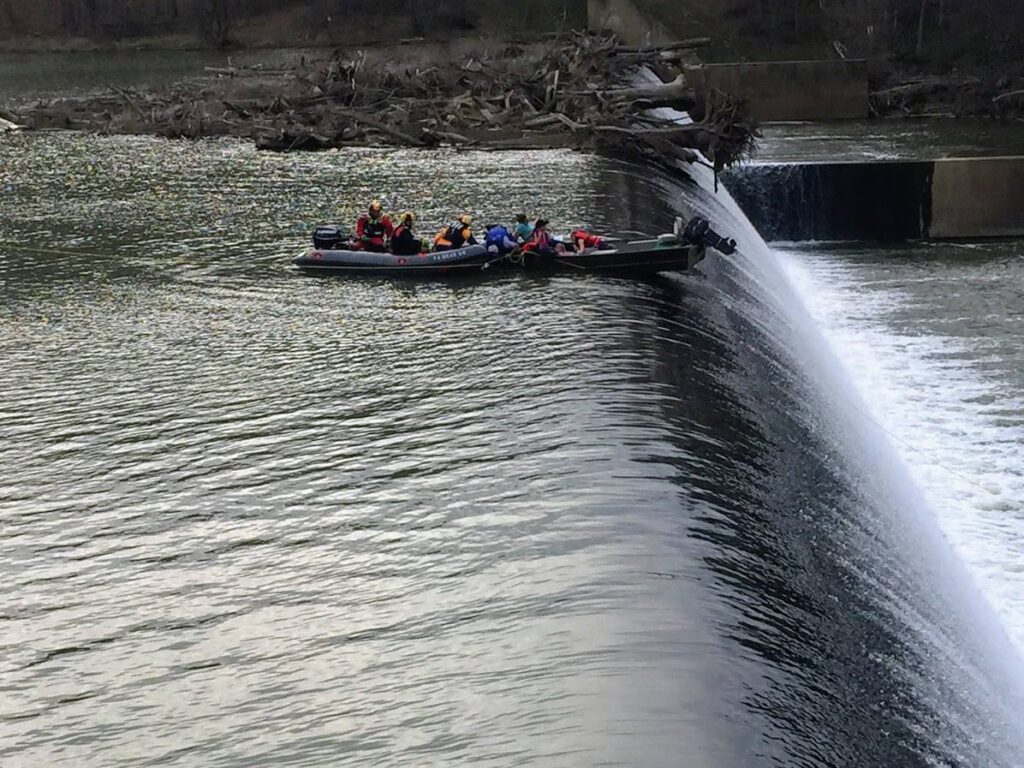
Loudoun County Fire and Rescue Department units from Ashburn, Leesburg and Lansdowne raced to the scene. Rescue boats from the Leesburg, Cascades and Lucketts stations were dispatched. Firefighters climbed onto a long, extended aerial ladder to try to reach the boaters, but they were too far away. Rescue crews hurriedly assembled beneath the dam in case the boat went over. Finally, one of the rescue boats reached the trapped family, and they were towed safely to shore.
“Swift water rescue incidents are among the most dangerous activities we perform,” then-Loudoun Fire & Rescue Chief Keith Brower said at the time.
That was no hyperbole. While firefighters face many different types of emergencies, having to enter powerful, dark, cold, swirling waters can be among the most daunting.
It’s generally called a “swift water rescue” although a still pond or a frozen lake can be just as challenging. These types of rescues are a specific discipline within the wider array of fire and rescue duties.
In Loudoun, it’s part of Fire & Rescue’s Special Operations division, which also includes incidents like hazardous material calls, extricating people trapped in vehicles, trench rescue, structural collapse rescues and more.
The firefighters who make up Loudoun’s swift water rescue team go through intensive training before becoming a member and then continue to train year round. This is critical because a water rescue is different from any other.

“Swift water is more of an art,” said Justin Green, the battalion chief of special operations with Loudoun Fire & Rescue. “When we run car accidents and we have to cut open vehicles – in general a Chevy pick-up truck is going to cut the same way whether it’s black colored or blue colored. But every water call we run is going to be different. The weather is going to be different. The water level is going to be different. No situation is going to be the same.”
DANGERS IN ASHBURN
In the Ashburn area, Green says water rescue teams face three specific types of calls. One is for people who get in trouble while taking part in activities on the Beaverdam Reservoir. They have had several calls there in recent memory – and as most local residents know – there have also sadly been a number of drownings.
Another hot spot for water rescues is along Ashburn’s stretch of the Potomac River, primarily in the Bles Park area. Green says the county has seen increased calls to both the reservoir and along the Potomac since the start of the pandemic, because people cooped up at home were looking to get outside.
“We go on roughly 25 to 30 water rescue calls in a typical year,” Green said. “The overwhelming majority of these are incidents in and along the Potomac River.”
Finally, the third water rescue challenge in the Ashburn area is our sheer number of ponds – often built as amenities or for stormwater retention for our many residential developments. People wind up in ponds, whether it’s a stray toddler who gets away from his or her parent or a wayward driver who misses a turn and ends up in the drink.
“There are more ponds than I even realized and more than most of your readers would recognize,” Green said. “We have had more than a few incidents in those ponds in the warmer months – and then in winter months too. We see a lot of pets out on the ice, and when there are pets on the ice, there will soon be humans on the ice.”
ICE RESCUES
Indeed, ice rescues are considered a type of water rescue, albeit a unique one that requires a whole different set of knowledge and skills.
“Ice rescue is related to water rescue, but with the added challenge that the cold makes fine motor skills disappear,” Green said. “For a victim in the water without thermal protection, the cold also impacts their decision-making.”
Swift water rescue technicians – as they are called – are trained first in pools and on area lakes and rivers. Once they have the main skills mastered, they can be trained as ice rescue technicians. Common ice calls include the aforementioned pets – as well as wildlife such as deer – who wander on the ice.
“There is different equipment that we have to use on ice rescues,” Green said. “We train our responders on how to self-rescue if they fall in before reaching a victim. We use ropes and ice picks to help support rescuers and victims getting in and out of a hole in the ice.”
Green admits that with our warming climate his agency has had fewer ice calls in the past few years. But this can be a blessing and a curse.
“Yes, we are seeing fewer calls, but what happens is that it doesn’t take very much cold weather to create a thin layer of ice and that thin layer can be very deceptive,” he said. “Unlike in years past, ice now often doesn’t get very thick. People intuitively think they can walk out on it, and it can’t support their weight.”
CRITICAL TRAINING
Firefighter Delaunte Allen didn’t think much about the dangers of water growing up in Capitol Heights, Md., so when he started training for the special operations team in 2022, it was a big surprise.

“I thought I was an OK swimmer, but I found out I was a below average swimmer. After a lot of practice, I’m an OK swimmer now,” Allen said. “It also definitely opened my eyes to the difference between swimming in moving water and just swimming in a pool. It was definitely harder than I thought it would be.”
The team spends time in pools working on skills that involve ropes and buoyancy devices. They go to local streams where they learn about working with the current versus against it, using the force of the water to help them instead of hindering them.
“They try to put you into situations that may be unlikely to happen, but if they do, it’s not your first time experiencing it, so you are more prepared to deal with it,” Allen said.
The swift water technicians team up with other agencies around the region to go out on rapidly moving rivers and practice boatmanship skills. They have metal frames designed to imitate the shape and size of a car, and work on getting “victims” out of these situations. In some training on artificial bodies of water, real vehicles are used to increase the verisimilitude.
Most parts of being a firefighter are intense. Fighting a huge blaze, entering a collapsed building, rappelling down a cliff face, saving a life or being unable to save a life – these are things most of us can’t imagine encountering even once, much less on a daily basis.
But having to enter dark, rushing waters where seconds count is one of the most unique challenges a firefighter can face.
“Having just returned from training … on the Potomac River in freezing conditions – at night – I can confidently say that we have the best trained and equipped swift water rescue technicians for the residents [of] Loudoun,” Green said.
===============
TURN AROUND, DON’T DROWN
One of the more common emergencies the swift water rescue teams respond to in Ashburn and surrounding areas is people who get in trouble after trying to drive on a flooded roadway. A mere 6 inches of flowing water is enough to lift a car and carry it away – into a pond, a culvert or a nearby stream.
“I can’t emphasize it enough,” said Justin Green, the battalion chief for Special Operations with Loudoun County Fire and Rescue. “Turn around. Don’t down. It’s a catchphrase – but you can’t see how deep it is. You can’t see if the road has washed away underneath the water.”
Green says people who end up in trouble after driving down a flooded street often do so because they’re in a hurry or they can’t think of an alternate route. So they forge ahead.
“Every time we rescue someone, they say, ‘I didn’t think it would happen to me,’” he added. “It’s not worth the risk.”


